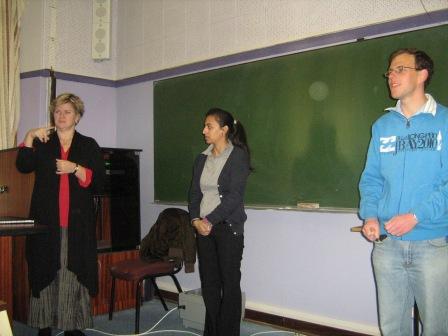
The Rhodes Linguistics 2 class had an exciting encounter with South African Sign Language (SASL) during a 12-day visit by Kirsty Maclons and Atiyah Asmal, two Sign Language teachers from Johannesburg and Cape Town. Their visit began with a special guest lecture by Atiyah Asmal and Hilda Mbetha, the Eastern Cape chairperson of DeafSA.
Both Hilda and Atiyah are Deaf, and used the lecture as an opportunity to tell their stories of what it is like to live in the Deaf world. They gave the lecture in SASL, with Kirsty interpreting for them. Hilda and Atiyah have very different stories: Hilda grew up in a very poor family on a farm outside Addo. She was sent to St Thomas’ School for the Deaf near King William’s Town, and learned SASL there from her peers, because in those days no signing was allowed in the classroom. By contrast, Atiyah is a fourth-generation Deaf person who acquired SASL from her parents in much the same way as other children acquire spoken languages from their parents. Both of them stressed that education for Deaf children needs to be improved to enable them to get Matric certificates and carry on to university: at the moment, very few Deaf South Africans have the opportunity to go to university. Kirsty and Atiyah work for a non-profit organization called Sign Language Education and Development (SLED) which exists to improve education for Deaf children.
For the next week-and-a-half, Kirsty and Atiyah gave the Ling 2 students an intensive crash course in SASL, including at least one lesson every weekday. Many students said that the course was their favourite experience of their careers in linguistics thus far, and Atiyah and Kirsty said the class learnt more quickly than any other group of university students they had taught. At the end of the course, all the students were able to hold a basic conversation with a Deaf person in SASL. On the last Friday night of the course, the students and teachers gathered at Grotto Mojito to enjoy a sign language party in which they signed to each other in a relaxed social context.
Ian Siebörger organized the basic SASL course as part of the Linguistics 2 module on Sign Language Linguistics, in which students learned the similarities and differences between spoken languages and sign languages when it comes to phonology, morphology, syntax and language acquisition. He would like to thank the Mellon Senior Scholars’ Fund for providing the finance to bring Kirsty, Atiyah and Hilda to Grahamstown.
